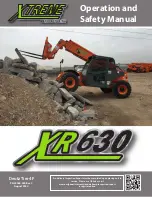
50
V. Structure and stability of truck
It is very important for operator to know the truck‘s structure and relationship between load and
stability.
Caution
The structure of the truck
The basic structure of the truck is mast (include mast and forks)
and body (include tire).
The lift truck keeps the balance of weight between the truck body
and the load on the forks with the center of the front wheels as a
fulcrum when the rated capacity load is placed in position.
Due care should be paid to the weight and the center of gravity of
loads to maintain the stability of the truck.
Caution
Load center
There is difference
because of the loads‘ shape, gravity,
such as box, board and large roller. It is very important to
distinguish the difference and the gravity center of loads.
Warning
If the truck is going to turn over, do not attempt to get out of the truck, because the speed of
overturn is much fast than you. You should hold the steering wheel handle, and this practice will
let you in the seats.
Please tie safety belt
Caution
Gravity and stability
Forklift stability depends on the common center of
gravity of the forklift. When the forklift is unloaded, the
center of gravity (CoG) remains unchanged. When the
forklift is loaded, the center of gravity is formed by the
combined center of gravity of the forklift and load.
The load's center of gravity depends on whether
the mast is tilted forward or backward, raised or
lowered, which means that the combined center of
gravity also changes accordingly.
The forklift's combined center of gravity is
determined by the following factors:
Load size, weight and shape;
Lifting height;
Mast tilt angle;
Tire inflation pressure;
Acceleration, deceleration and turning radius;
Driving surface conditions and inclination;
Attachment type.
WARNING
Faste Seatblet
Do Not Jump!
Brace
Feet
Hold
on
Tight
Lean Away
From Impact
Truck can
TIP OVER!
Risk of serious
INHURY
or DEATH!




































